Persepolis; The Great Ancient Persian Capital
There are numerous attractions in Shiraz, such as the Nasir al-Mulk Mosque of Shiraz and Hafiziyah.
Still, today we are heading to one of the city's top attractions and a UNESCO World Heritage Site in Iran, which has long served as a symbol of that nation's civilization and culture. To explore this region, many tourists visit Shiraz each year. Shiraz is known for Parse, Persepolis, Forty Minars, Hazar Seton, and ultimately as the illustrious capital of the Empire of Iran. Persepolis City is one of the greatest ancient sites and tourist attractions in Iran. This stunning historical structure belonged to the Achaemenid Empire and has a long history of being a hub for rites and festivals, particularly Nowruz ceremonies. In Shiraz, Persepolis is still recognized as the most spectacular architectural building.
Iran's Persepolis History
"In Persia first arises that light which shines itself and illuminates what is around... The principle of development begins with the history of Persia; this constitutes therefore the beginning of history."
(Hegel, 1857, p.)
Where Persepolis is Located in Iran

From the time of Darius, I (the Great, r. 522-486 BCE) until its fall in 330 BCE, Persepolis reigned as the capital of the Persian Achaemenid Empire.
Under Darius I, who sought to give the Persian government's administration a new beginning and transferred the capital from Pasargadae, construction started between 518 and 515 BCE (the capital established by Cyrus the Great, r. c. 550-530 BCE). However, due to the city's remote location in the highlands and the difficulty of traveling there during the Persian winter's rainy season, Ecbatana, Babylon, and Susa also served as the Achaemenid Empire's administrative centers.
Persepolis, which served as the king's summer and spring residence, appears to have been built to serve as a gathering place for subject state leaders to attend formal ceremonies.
The complex has five "palaces" or halls of varied sizes, as well as spectacular entrances, and is elevated high on a walled platform. Persepolis' purpose is still mostly unknown. It wasn't one of Persia's major towns, much alone the rest of the empire; instead, it seems to have been a lavish ceremonial structure that was only inhabited sometimes; the whereabouts of the king's private chambers are still a mystery. Most archaeologists believed, up until recent challenges, that it was explicitly used to celebrate Nowruz, the Persian New Year, which is still a significant yearly festival in contemporary Iran and is observed during the spring equinox.
| Also read about: Sassanid Empire - Rise and Fall of the Sasanians (Another Persian Empire)
Persepolis Definition
The Persians referred to it as Parsa, although its name derives from the Greek Perses-polis (Persian City) (City of the Persians); Persepolis pronunciation in America is "pr.seh.puh.luhs", and in Persian, it is pronounced as پِرسِپولیس.
Who Destroyed Persepolis

Alexander (the Macedonian) overran Persepolis, the Persian capital city, in the year 330 BCE. He looted the city's valuables before setting fire to the enormous palace and the nearby city.
When Alexander the Great entered Persepolis, it was the crown jewel of Persia. When he departed, however, it was a ruin, and the location would only be remembered for decades as "the site of the forty columns" due to the last few palace columns that were left standing in the sand.
The very following morning and for the rest of his life, Alexander began to regret the destruction his invasion had brought about.
After settling in Iran for a long time, Alexander the Great became fascinated by the culture and people of Iran, so after a while, he stopped wearing Macedonian robes and wore Iranian robes. He followed Iranian customs, preferred Iranian food over Greek and Macedonian food, and he encouraged Greeks and Macedonians to marry Persians.
He was greatly disturbed by what he discovered when he came to Cyrus the Great's looted tomb at Pasargad, a little town north of Persepolis, and he promptly ordered repairs to be done.
| Suggestion: Naqsh-e Rustam | Ancient Treasures & Zoroastrian Legacy
Geography of Persepolis

Persepolis is located near the confluence of the Kor and Pulvar (Sivand) rivers.
The location has a 125,000 square meter (1,350,000 square foot) terrace, which is somewhat man-made and partially carved out of a mountain, with its east side leaning on Rahmat Mountain. Retaining walls, whose height varies according to the slope of the ground, make up the other three sides. A double staircase on the west side rose from 16 to 43 feet (5 to 13 meters) in height. It then softly slopes to the peak from there. Depressions were filled with dirt and large boulders, which were fastened together with metal clips to form the flat Terrace.
| Also read about: Bisotun - Rock Relief and Inscription of the Achaemenids
Persepolis Art and Architecture
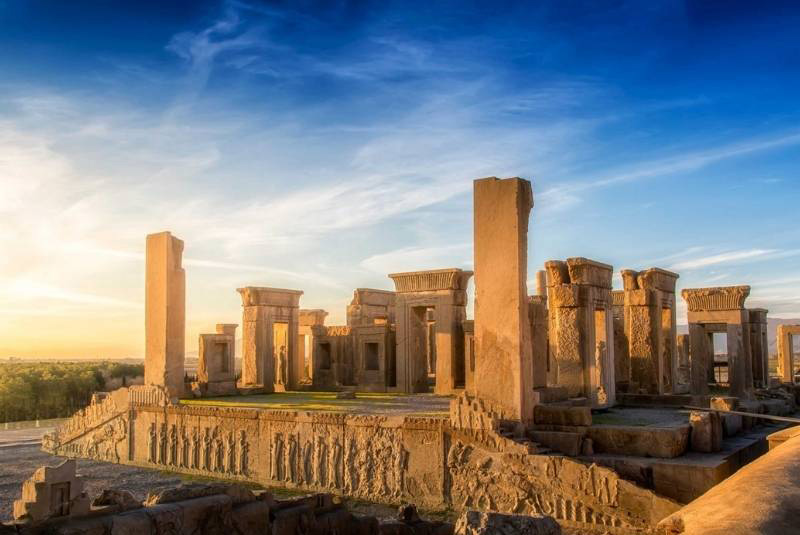
The Persian column, which was possibly based on previous wooden columns, is a notable feature of the Persepolis architecture. Architects turned to stone when Lebanon's biggest cedars or India's greatest teak trees failed to meet the necessary dimensions. Even on wooden shafts, column bases and capitals were built of stone, but it's likely that wooden capitals also existed. The world's best-skilled engineers, architects, and artists were gathered in 518 BC to participate in the construction of the first structure, which would serve as a representation of world peace, equality, and togetherness for thousands of generations.
Persepolis Palace Complex: Architecture
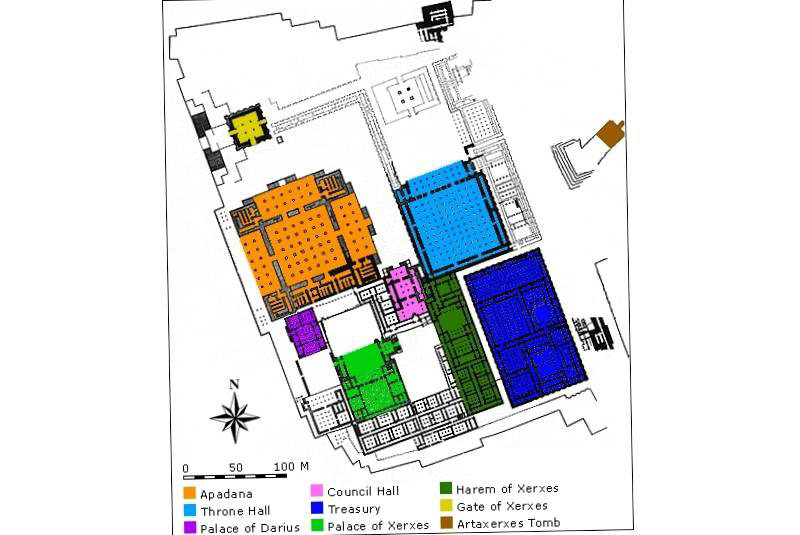
The structures in Persepolis may be divided into three general categories: The Treasury, the royal reception areas, and the military quarters. Apadana, the Hall of a Hundred Columns, the Tripylon Hall, the Tachara, the Hadish Palace, the Palace of Artaxerxes III, the Imperial Treasury, the Royal Stables, and the Chariot House are a few notable buildings.
According to an inscription etched into the Terrace's southern face, Darius the Great was the creator of Persepolis. Although construction began in 518 B.C., Artaxerxes I took nearly 100 years to complete the enormous work. Much work needed to be done before any structures could be constructed. This mainly necessitated cutting into an uneven and rocky slope to shape and elevate the vast platform and fill the gaps and depressions with debris.
It appears that Darius designed this impressive complex of palaces not only as the seat of government but also, and mainly, as a show spot and a magnificent center for the gatherings and festivals of the Achaemenian monarchs and their empire, according to tablets inscribed in Old Persian and Elamite discovered at Persepolis. Darius only lived long enough to see some of his ambitions come to fruition.
When discussing the Persepolis platform, it is important to note that the northern portion of the Terrace, which was primarily made up of the Throne Hall, the Gate of Xerxes, and the Audience Hall of the Apadana, described the official portion of the Persepolis complex and was only open to a select group of people. The Harem, the Council Hall, and other facilities were located in the other section of the city. The Terrace complex is made up of the buildings listed below, along with some of its most notable characteristics.
| Suggestion: Taq Bostan - Sassanid Rock Reliefs in Kermanshah, Iran
The Apadana

The Apadana, which was started by Darius and completed by Xerxes, is by far the largest and most spectacular structure. The monarchs mainly utilized it for grand celebrations. On the large platform, to which two massive staircases, one on the north and one on the east, provide access, thirteen of its seventy-two columns still exist. They are decorated with rows of exquisite reliefs depicting scenes from the New Year's festival as well as processions of representatives from the 23 Achaemenid Empire subjects' countries, including court notables, Persians, and Medes, followed by military men and guards, their horses, and royal chariots.
Delegates deliver presents as a sign of their allegiance and as an homage to the monarch while dressed in their national garb, some of which are entirely Persian in design. These presents include vases and containers made of silver and gold, weapons, woven textiles, jewels, and animals from the nations of the delegates. Although the basic layout of the scenes appears repetitious, there are noticeable changes in the outfits, headpieces, hairstyles, and beards that give each delegation its own unique character and clearly identify its place of origin.
Another way the design creates diversity is by employing stylized trees to create beautiful bands or to divide different groups or activities. A grandiose ornamental impression is also conveyed by the deliberate use of patterns and rhythms, which repeat figures and groups.
The Throne Hall of Persepolis
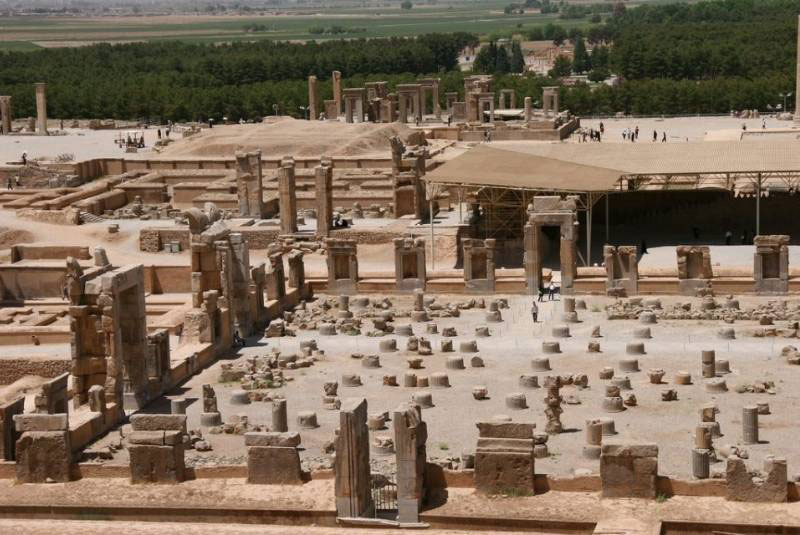
The Throne Hall, also known as the "Hundred-Column Hall," is the second-largest structure on the Persepolis Terrace after the Apadana. It was begun by Xerxes and finished by his son Artaxerxes I. (end of the fifth century B.C.). Its eight stone entrances are embellished with throne scenes on the north and south and pictures of the king battling monsters on the east and west.
Additionally, two enormous stone bulls stand on either side of the building's northern portico. The Throne Hall was primarily utilized at the start of Xerxes' rule to host parties for delegates of all the empire's subject countries. Later, when the Treasury proved to be insufficient, the Throne Hall also served as a warehouse and, more importantly, as a location to show items—honor and booty—from the royal Treasury more advantageously.
| Discover: Susa Persia - One of the Oldest Cities in the World
The Treasury of Persepolis

The Treasury, part of which functioned as an armory and particularly as a royal storeroom of the Achaemenian rulers, is located next to the Throne Hall. The enormous riches that were kept here were obtained through the loot taken from conquered peoples and the yearly tribute that the empire's citizens brought to the monarch in celebration of the New Year's feast.
Before the Throne Hall was completed, a Court of Reception was held in the Treasury's largest room. Here, two sizable stone reliefs that attested to its function were found. These show Darius I seated on his throne being approached by a high dignitary who is making a courteous welcome gesture with his hand to his lips. Crown Prince Xerxes is positioned behind the monarch, followed by court officials.
The Palace of Darius (Tachara Palace of Persepolis)
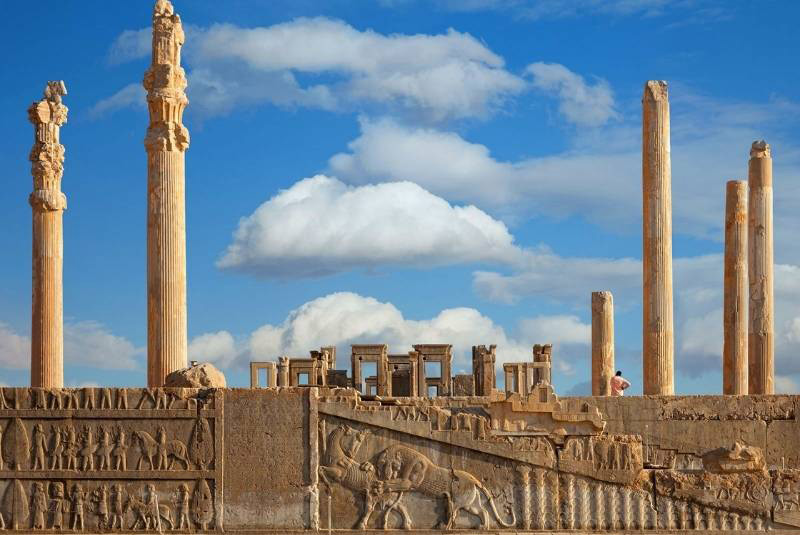
Twelve columns supported the center hall's roof, and three little stairs led down from it. On these stairways, reliefs show servants ascending the steps while bringing covered platters of food and animals for the king's banquets. Relieves on the northern and southern doorways depict the king engaged in battle with monsters. At the same time, reliefs on the eastern and western doorjambs demonstrate the king leaving the palace in formal attire, accompanied by two attendants.
| Discover: Shahr-e Sukhte - The Beginning of Civilization in 3200 BC
The Palace of Xerxes (Hadish Palace Persepolis)

Except for two enormous Xerxes inscriptions on the eastern and western gateways, Xerxes' Palace's stone doorframes and windows have ornamental elements that are nearly twice as compared to those of Darius'. These doors feature servants with ibexes rather than the king engaged in battle with monsters. Sadly, these palace's reliefs are all far more poorly protected than those at the Palace of Darius.
The Council Hall of Persepolis
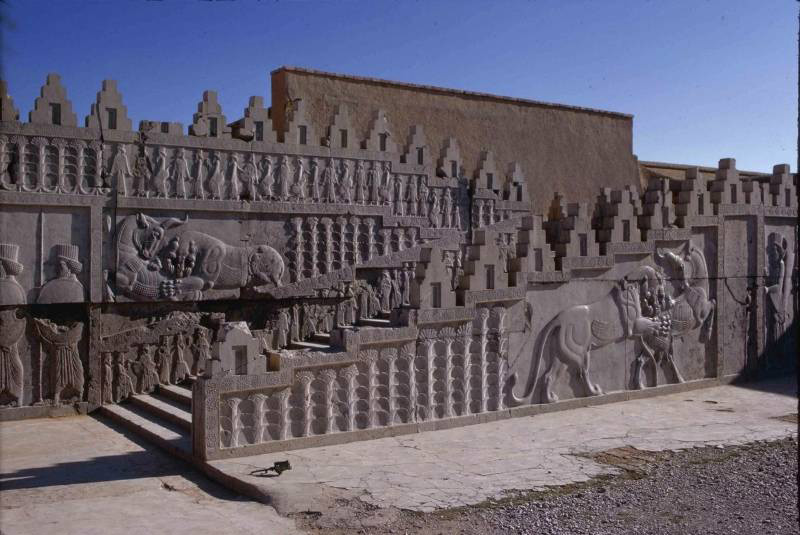
Three doors on a magnificent staircase provided access to the royal rooms. The first two were for authorized access, and the third was a covert entrance to the Harem.
| Suggestion: Arg-e Bam - The Fascinating Citadel of Ancient Persia
The Gate of the Nations (The Gate of Xerxes)

The remarkable Gate of Xerxes, from which a wide stairway descends, is located north of the Apadana. Because it was the sole entry into the Terrace and through which all guests had to pass on their way to the Throne Hall to pay tribute to the monarch, Xerxes, who erected this structure, gave it the moniker "The Gate of the Nations." The structure was made of a single, large chamber, the roof supported by four stone columns with bell-shaped bases. A stone bench ran parallel to the room's interior walls, split only by the doors.
The building's mud-brick solid outer walls were embellished with many niches. There was a massive stone gateway on each of the three walls' east, west, and south sides. The western gate was defended by a pair of enormous bulls, while the eastern entrance was guarded by two human-headed winged bulls (lamassu). A trilingual inscription attesting to the construction and completion of the gate by Xerxes is carved above each of the four colossi. The southernmost entryway, which faces the Apadana, is the largest of the three.
They must have had two-leaved doors, which were most likely formed of wood and coated with sheets of decorative metal, as pivoting mechanisms were discovered on the inner corners of every entry.
The Harem of Xerxes
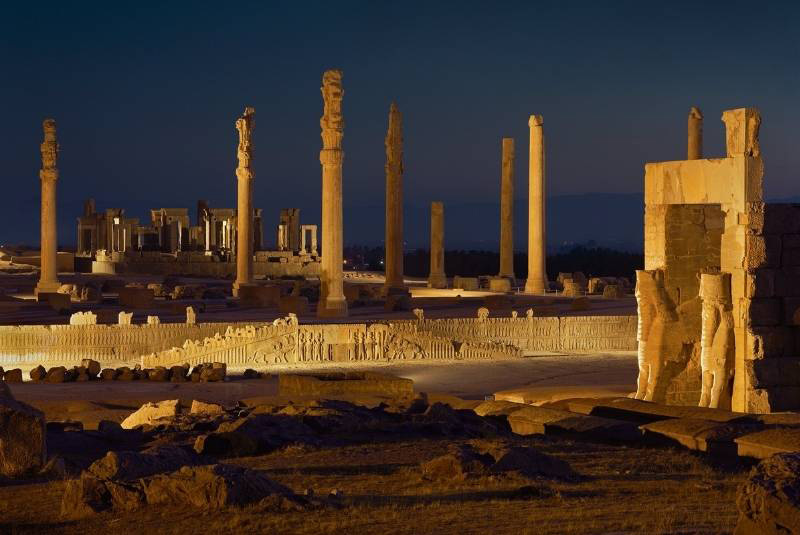
The royal ladies' residence, known as the Harem, was designed in the shape of an L. The west wing stretched westward from the southern end of the central wing, which had a north-south orientation.
The primary wing's focal point was a sizable centrally located columned hall with a portico looking out into a vast courtyard on the north. Four entrances with relief-decorated jambs adorned the lobby. The southern doorway's frames have a picture of Xerxes entering the hall. A fly whisk and a parasol are being held over the king's head by one of the two servants who are trailing him. A relief depicting Xerxes defeating a monster with a lion's head may be seen on the frame of the eastern entryway.
The monarch and a lion are engaged in battle in the reliefs over the western entryway. Although the queen's chambers are unknown for sure, she and her retinue were most likely housed in this magnificent center area. The primary wing's main section had six apartments grouped in two rows to the south of the columned hall. Each apartment had a massive room with pillars and one or two smaller rooms. Sixteen other flats with a similar layout were located in the west wing.
Two stairs linked the west wing with the Palace of Xerxes in addition to the entrance from the Council Hall to the northern portion of the main wing of the Harem. Two entries led to walled gardens or courtyards as well. It's possible that a third exit at the western wing's eastern end went to a space that was either open or had its boundaries demolished. The front of the Harem was restored and made into a museum to display some of the objects found at Persepolis.
| Suggestion: Iran's Ziggurats - Unveiling the Secrets of the Past
The Royal Tombs at Persepolis
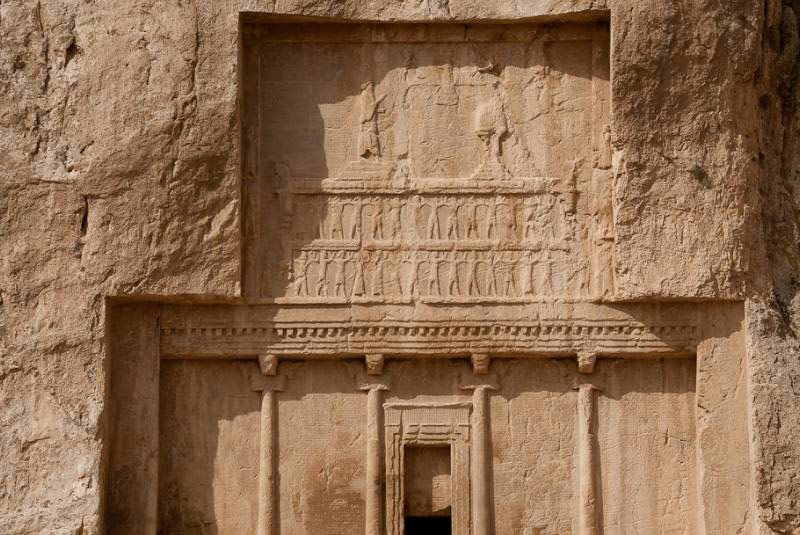
In the Husain Kuh Rocky Mountains, about 4.8 kilometers northwest of Persepolis, is the spectacular site of Naqsh-i-Rustam, where Darius the Great and his descendants had their towering graves cut into the rock.
Darius the Great was the first to pick Naqsh-i-Rustam as a burial site, even though it had long been considered a hallowed location (as the ruins of a Pre-Achaemenid relief reveal). In addition to copying his concept for a cliff burial, his successors also replicated the tomb's design. The tomb's striking exterior is designed to resemble a cross.
The tomb chamber has an entrance that is carved deeply into the rock. A relief of the king standing in front of an altar on a three-stepped pedestal may be seen in the panel above this doorway. He makes the worshipful gesture of raising his hand. The winged disk of Ahuramazda, the Zoroastrian divinity, floats above him. Throne bearers in this picture represent the twenty-eight countries of the empire. The Persian guards and the weapon-bearers for the monarch are depicted on the side panels.
| Suggestion: Top 10 Historical Sites of Iran
Treasury and Other Discoveries of Persepolis
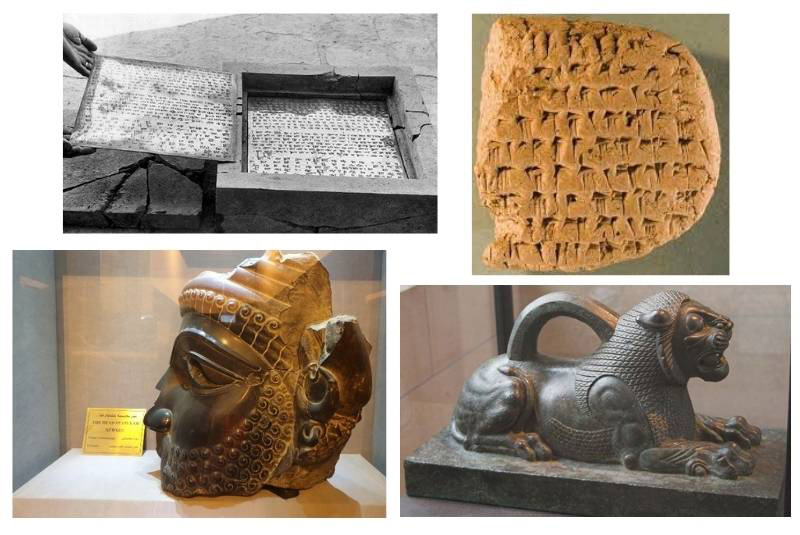
There is no doubt that the wealth of Persepolis was accurately described by early historians; Persepolis was the wealthiest city under the sun, and her homes were filled with gold, silver, and other kinds of treasures.
Historians' accounts suggest that the Oriental Institute's excursions were expected to find many artifacts. Unfortunately, in 331/30 B.C., Alexander and his army thoroughly looted and burned Persepolis. The items the Macedonians either missed or unintentionally dropped were what the Oriental Institute found.
Findings from the royal storeroom in the Treasury made up by far the majority of the total. Far fewer different artifacts came from the Terrace's other structures. Numerous of these discoveries were looted from conflicts with other countries like Greece, Egypt, and India or tribute items from the empire's vassal states. Some native artifacts blatantly display influences from different cultures. The fact that Darius I invited a large number of foreign artists and artisans to his court is known because of the discovered tablets. The Persians used their talent and inspiration but never imitated them.
| Read more: Persian Garden - A Piece of Paradise in Iran
Cuneiform Tablets

There were a large number of clay tablets with Elamite cuneiform writing that were found among the wreckage of the Treasury. The enormous fire that destroyed the structure cooked these tablets, which were initially sun-dried, such that many of them were discovered intact rather than having long since crumbled to dust.
These tablets, which were primarily inscribed in Old Persian and their translations of Elamite and Babylonian, were precious to the archaeologists. They tell us that talented artisans from several sections of the empire, including Egyptians who worked on stone reliefs and inscriptions, Caria goldsmiths, and Susa ornament makers, were present in Persepolis.
Some tablets also provide information on the month and year of either Darius' or Xerxes' rule, the date a certain task was completed, and the amount of payment—either in kind or cash—the employees got. Other tablets contain records of purchases, land agreements, taxes payable, or the sums borrowed from the Treasury. Last but not least, some tablets specify how much haoma—the revered alcoholic beverage—should or might be consumed during cult rituals.
| Also read about: Tehran's Most Famous Palaces
Seals
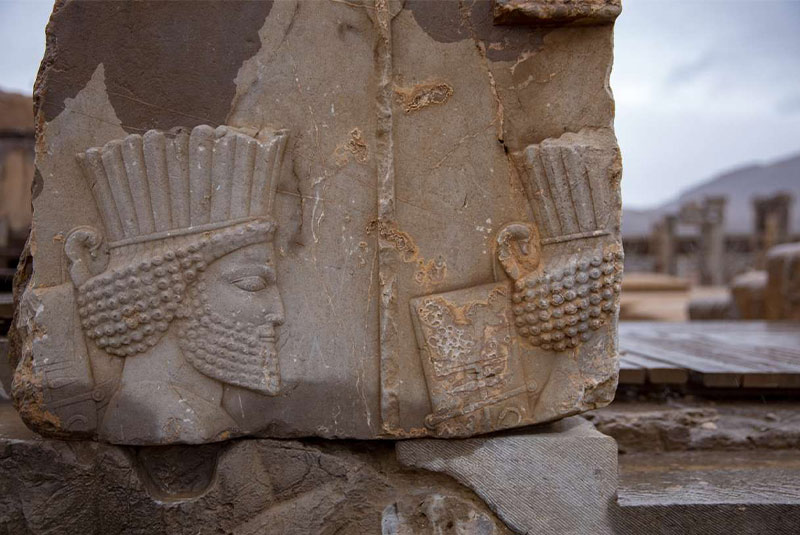
The writings found on seals, wall pegs, and foundation slabs were significantly responsible for helping archaeologists determine the dating of the Persepolis findings. Each often wore the name of the local Achaemenid king. Cylinder seals, which are often fashioned of stone, frequently show, among other things, hunting or combat scenes, ceremonies, offerings, or animal battles. The royal seals of Darius and Xerxes consistently show a king triumphant in the battle against dangerous beasts or monsters, a scene that is also shown in the royal relieves.
Other Findings on Persepolis
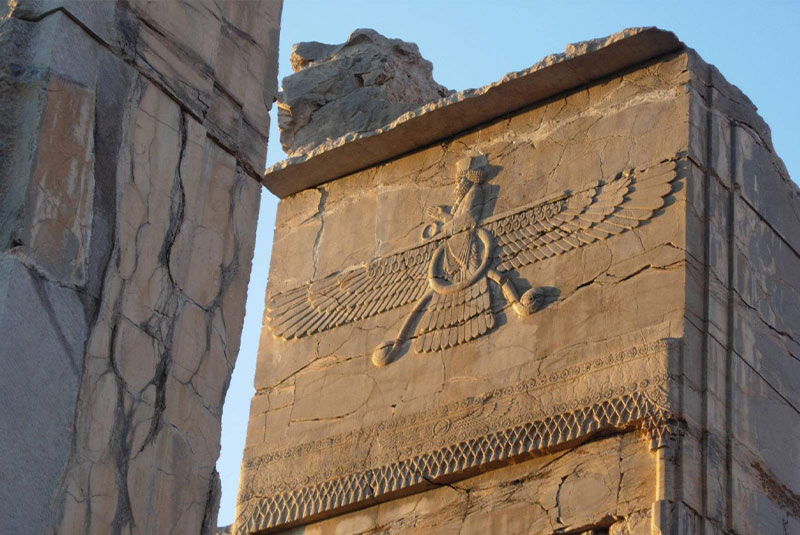
The debris of Persepolis also contained pieces of vessels with inscriptions indicating their use at the king's table. Other discoveries included tools, weights, mortars, and pastels. Hundreds of items of combat gear, including arrowheads, scabbard points, and bridle decorations, were also discovered in the Treasury and the garrison quarters.
Only a few pieces of jewelry, a few gold and silver coins, and some silver buttons were discovered after Alexander's forces had destroyed and looted Persepolis; not a single precious metal vessel was retrieved. Nevertheless, a number of alabaster bowls and bottles were discovered, some of which had inscriptions and dates demonstrating that they were gifts transported from Egypt to Persepolis during the reigns of Darius and Xerxes. Other vessels were fashioned of "Egyptian blue," a synthetic copper-calcium-tetrasilicate combination that is bluish-green in color. These were highly prized imports from Egypt, where the method for making this paste had been discovered in the Fourth Dynasty.
| Read more: Taq Kasra - World's Largest Single-Span Brick Vault
Persepolis Ruins and Remains

On the Terrace are the ruins of several enormous structures. All are made of marble, which is a dark gray color. They still have 15 of their pillars standing. Since 1970, three more pillars have been rebuilt. Many of the structures were never completed.
The most priceless records from the Achaemenid era may be found among the more than 30,000 inscriptions that have been discovered so far from the excavation of Persepolis. These inscriptions are modest and succinct in terms of size and wording. These inscriptions, the majority of which are presently housed in the United States, suggest that wage employees received payment throughout the Persepolis era.
| Also might be interesting: Takhte Soleyman (Throne of Solomon) - UNESCO World Heritage Site
Bottom Line
One of the must-see locations in Shiraz is Persepolis, a monument to the grandeur of pre-Islamic Iran. One of the most significant records of human civilization's history may be found in the Persepolis area and its surviving structures. As a result, prominent researchers and archaeologists have journeyed to Iran to see Persepolis.
The city was lost to time as it lay crushed beneath the weight of its own devastation (although, for a while, it was still officially the capital of the now-defeated empire). Residents in the region simply referred to it as "the location of the forty columns" because some were still standing among the debris.
Except when armed turmoil in the area prevented them, excavations at the site have proceeded since 1931 C.E. It is currently a historical site in the Fars region of Iran, northwest of the city of Shiraz. It attracted tourists from all over the world who came to witness the wonder that was once the magnificent metropolis of Persepolis when it was named a UNESCO World Heritage Site in Iran in 1979.
Share your story!
Comment below and let us know about your Experience.
Your story inspires others!


Comment
Leave a Comment